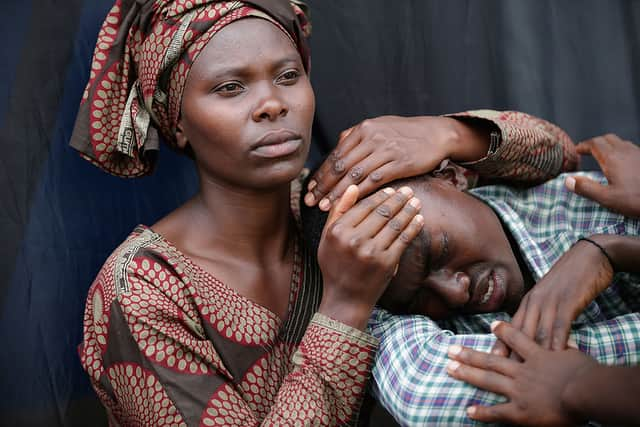Rwandan genocide: Tutsi and Hutu 1994 conflict and massacre in Rwanda explained, and human rights
and live on Freeview channel 276
The Prince of Wales will spend his first full day in Rwanda meeting survivors and perpetrators of the country’s 1994 genocide, prior to attending a summit of Commonwealth leaders.
Charles has been encouraged by former Rwandan footballer Eric Murangwa to visit a church outside the Rwandan capital where the remains of tens of thousands of genocide victims are buried.
Advertisement
Hide AdAdvertisement
Hide AdIn April, Boris Johnson described Rwanda as one of the safest countries in the world and warned critics of the “risk of stereotyping” after concerns were raised about its human rights record.
Under plans, some of those who attempt to enter the UK by routes deemed “illegal” by the Government will be sent more than 4,000 miles to Rwanda while their claims are assessed.
Steve Valdez-Symonds, Amnesty International UK’s refugee and migrant rights director, warned that sending people seeking asylum in the UK to another country “let alone one with such a dismal human rights record” is “the very height of irresponsibility”.
Rwanda has been accused of human rights abuses on more than one occasion. Perhaps its most infmaous incident is that of the Rwandan genocide of the Tutsi people in 1994.
Advertisement
Hide AdAdvertisement
Hide AdBut what was the Rwanda genocide, and what legacy has it left on the country?
Here is everything you need to know.
What was the Rwandan genocide?
In 1994, the Hutu ethnic group made up about 85% of the population of Rwanda, but for a long time, the minority Tutsi group ruled with greater authority.
In 1959, the Hutus overthrew the Tutsi government and took power. Many Tutsis fled to surrounding nations in their tens of thousands.
A rebel organisation was founded by a group of exiled Tutsis called the Rwandan Patriotic Front (RPF), which invaded Rwanda in 1990.


Advertisement
Hide AdAdvertisement
Hide AdThis sparked the Rwandan Civil War, which led to widespread conflict between the two sides until a peace treaty was signed in 1993.
Then, in 1994, the Presidents of Rwanda and Burundi (both Hutus) were on an aircraft that was shot down.
Who exactly downed the aircraft is still unknown to this day; the RPF claimed Hutu extremists had shot down the plane themselves to escalate tensions, while the Hutus blamed the RPF.
Hutu militias blocked roads across Kigali, Rwanda’s capital city within a half-hou, and every passing vehicle was stopped; they killed any Tutsis they could find.
Advertisement
Hide AdAdvertisement
Hide AdThe Interahamwe and the Impuzamugambi were the two main militia organisations responsible for the killings.
These were meant to be the youth wings of two Hutu-friendly political parties, but the government formed them into militias to carry out the executions.
Militias and civilians were gathered by military leaders in Rwanda’s provinces, and ordered to kill Tutsis – including babies.
The crisis lasted 100 days and claimed the lives of 800,000 Tutsi people at the hands of extremist members of the Hutu, making it one of the fastest genocides the world has ever known.
Advertisement
Hide AdAdvertisement
Hide AdHutu militias and the Rwandan army also worked their way through a list of people in the government who were political moderates, so they would not be able to stop the genocide.
They killed journalists and human rights activists who had spoken out against the killings. 96 individuals were later indicted in the as International Criminal Tribunal for counts of genocide, crimes against humanity or war crimes.
What is Rwanda like today?
Rwanda is one of the most densely populated countries in the world, and still among the least developed despite its focus on modernising following the country’s 1994 genocide.
The migrants who sought better lives in Britain are anticipated to find fewer chances to follow their goals here, even as Rwandan authorities characterise their country as having a great history of accepting people in need.
Advertisement
Hide AdAdvertisement
Hide AdRwandan President Kagame has been keen to develop a positive image of the country, though experts have accused him of blocking entry to Rwanda for certain academics and journalists, and threatening and assassinating critics of the regime to achieve this.
In 2009, the Rwandan government worked with US public relations firm Racepoint Group to improve the perception of its human rights record, and has even recently made efforts to point the finger of blame at other countries.
In April 2021, a report commissioned by the Rwandan government concluded the French government bore a “significant” responsibility for “enabling a foreseeable genocide”.
The 600-page report said France “did nothing to stop” the massacres, and in the years after the genocide tried to cover up its role and even offered protection to some perpetrators.
Comment Guidelines
National World encourages reader discussion on our stories. User feedback, insights and back-and-forth exchanges add a rich layer of context to reporting. Please review our Community Guidelines before commenting.
